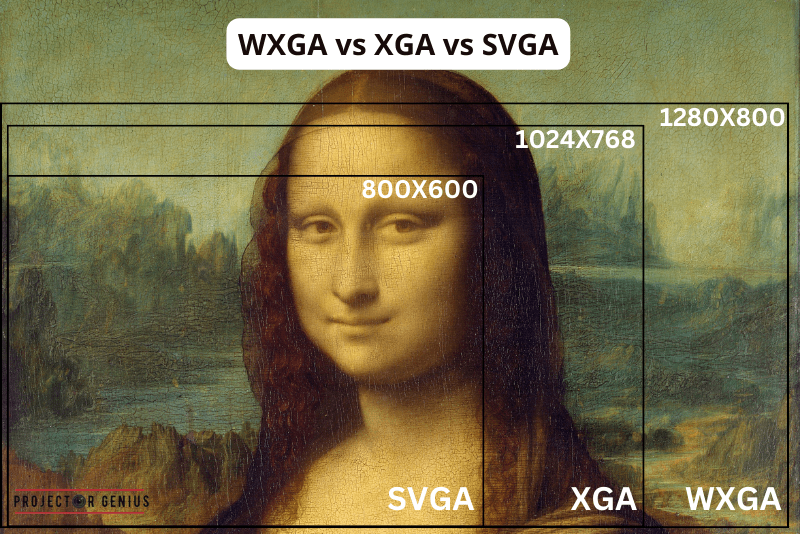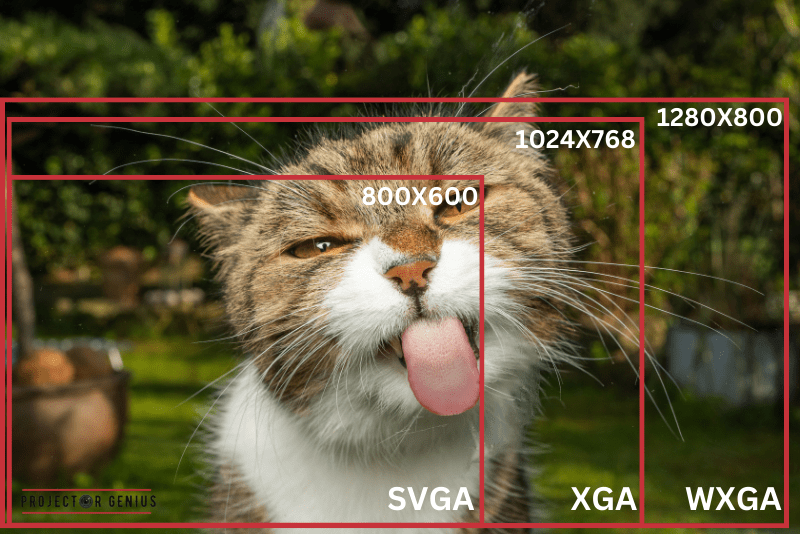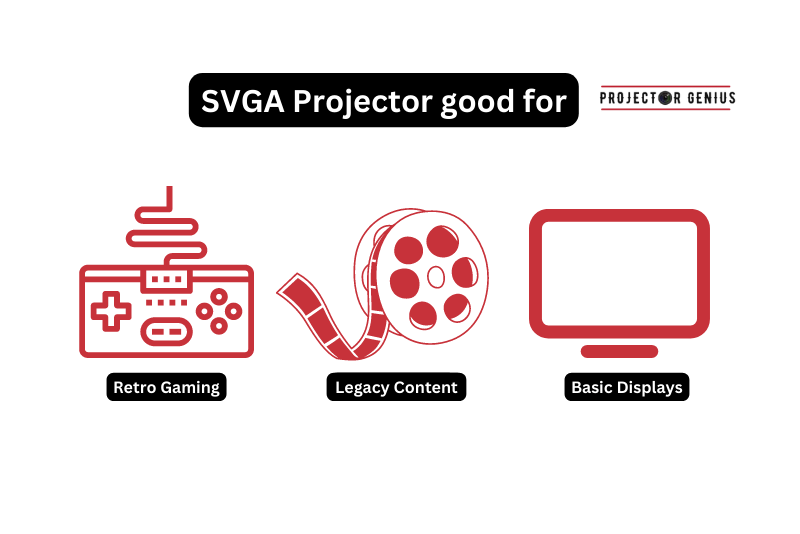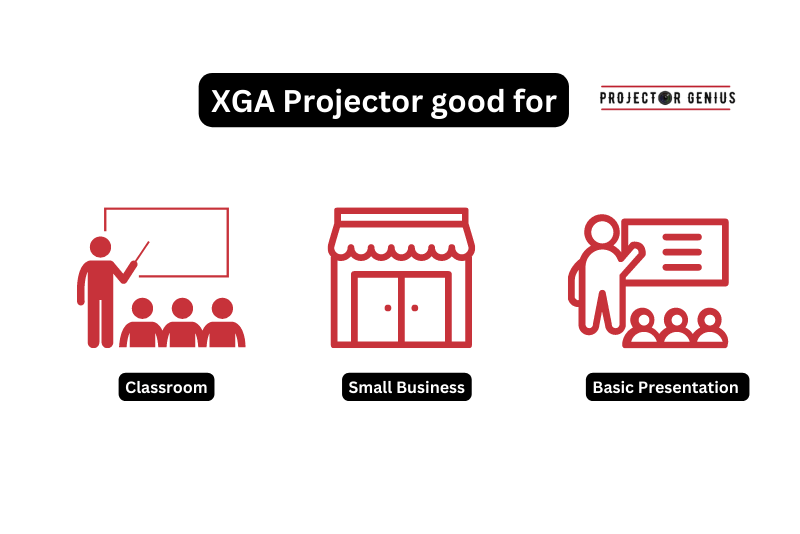WXGA vs XGA vs SVGA: Which Should You Buy In 2023?
-
 Written by:
Kristy Roger
Written by:
Kristy Roger
- Last Updated:
WXGA vs XGA vs SVGA are different standard projector resolutions used in the context of computer monitors, projectors, and display devices. The main differences between them lie in their resolutions and aspect ratios. Here’s a detailed comparison:

I recommend using the Table of Contents to quickly access the information you need.
My article is designed to cater to home cinema users of all levels, from Beginners to Advanced enthusiasts.
Table of Contents
SVGA (Super Video Graphics Array)
– SVGA is the oldest Resolution:800 x 600 pixels
– Aspect Ratio: 4:3.
– Commonly used in older CRT monitors and projectors.
– Offers a basic level of image detail and is suitable for simple graphics and presentations.
– Becoming less common as higher-resolution formats have become more popular.
Read Full Information: Is SVGA Worth it?
XGA (Extended Graphics Array):
– Resolution: 1024 x 768 pixels
– Aspect Ratio: 4:3.
– Became popular in the late 1990s and early 2000s as a higher-resolution upgrade from SVGA.
– Offers a better level of image detail and clarity compared to SVGA.
– Commonly used in older computer monitors and projectors, but has been largely replaced by higher-resolution formats like WXGA and Full HD.
Read Full Information: Is XGA Worth it?
WXGA (Wide Extended Graphics Array):
– Resolution: Comes in two variations:
– WXGA (1280×800 pixels): Aspect Ratio – 16:10.
– WXGA (1366×768 pixels): Aspect Ratio – 16:9.
– Offers widescreen aspect ratios, making it suitable for displaying cinematic content and multimedia presentations.
– WXGA (1280×800) is commonly used in laptops, smaller projectors, and some widescreen computer monitors.
– WXGA (1366×768) is often used in budget-friendly TVs and smaller display devices.
– Provides higher image resolution compared to both SVGA and XGA, making it more suitable for detailed graphics and multimedia content.
Read Full Information: Is WXGA Worth it?
In summary, SVGA, XGA, and WXGA are different resolutions with varying aspect ratios. SVGA and XGA have a 4:3 aspect ratio and are older standards, while WXGA offers widescreen aspect ratios (16:10 or 16:9) and provides higher image resolution. As technology has progressed, higher-resolution standards like Full HD and 4K resolution have become more common, rendering SVGA and XGA less prevalent in modern devices. WXGA remains in use, especially in laptops, smaller projectors, and lower price tag display devices.
Which is Better WXGA or SVGA?
how to choose between SVGA and WXGA? In terms of image quality and highest resolution, WXGA is better than SVGA resolution. Here’s why:
WXGA stands for Wide Extended Graphics Array and has a higher resolution of either 1280 x 800 pixels or 1366×768 pixels, depending on the specific variation. It offers more number of pixels and a widescreen aspect ratio (16:10 or 16:9), providing a higher level of image detail and clarity compared to SVGA.
SVGA stands for Super Video Graphics Array on the other hand, has a lower resolution of 800×600 pixels and a 4:3 aspect ratio. While SVGA might have been suitable for basic graphics and presentations in the past, it now falls short in providing the image quality and level of detail that users expect in modern display devices.
When choosing between WXGA and SVGA, it’s essential to consider the intended use and the type of content you’ll be viewing. If you need a higher-resolution display for detailed graphics, multimedia, and movies, WXGA is the better choice. It is suitable for a wide range of applications, including laptops, smaller projectors screen, and some widescreen computer monitors.
In contrast, SVGA is an older standard and may still be found in some legacy devices or budget-oriented systems. However, for most modern applications and devices, WXGA is the preferable choice due to its higher image resolution and widescreen aspect ratio, providing a more engaging and visually appealing viewing experience.
WXGA vs XGA vs SVGA: Which Resolution is Best For Your Projection?
The best resolution for your projection depends on several factors, including the intended use, the size of the screen or projection area, the content you’ll be displaying, and your budget. Here are some considerations to help you decide:
- WXGA (1280×800 or 1366×768): WXGA resolutions are a good compromise between affordability and image quality. They are suitable for various applications, including presentations, multimedia content, and basic entertainment. Choose WXGA if you have a widescreen aspect ratio display or if you want a more cheap option.
- XGA (1024×768): XGA is an older standard that still finds use in certain scenarios. It offers a good balance between image quality and affordability and is suitable for basic presentations and general content.
- SVGA (800×600): SVGA is the most budget-friendly option and can work for very basic presentations and simple content. However, its low resolution may not provide the level of detail and clarity found in higher-resolution types of projectors.
Additionally, consider the content you’ll be displaying and whether it is available in the resolution you choose before buying a projector. With the right resolution and setup, you can enjoy a captivating and immersive projection experience that suits your preferences and requirements.

Best Use of SVGA
The best use of SVGA (Super Video Graphics Array) is in situations where a low-cost and basic projection solution is required. While SVGA has a relatively low resolution of 800×600 pixels and a 4:3 aspect ratio, it can still be suitable for specific applications. Here are some scenarios where SVGA might be the best choice:
1. Basic Presentations
SVGA projectors are adequate for basic applications such as PowerPoint presentations and displaying simple graphics or charts. If you need to deliver straightforward information without requiring high-resolution visuals, SVGA can be sufficient.
2. Small Meetings or Classrooms
In small meeting rooms or classrooms where the screen size is relatively small and image quality is not the primary concern, SVGA projectors can offer a cost-effective solution for sharing content with a group.
3. Budget-Conscious Users
If you are on a tight budget and don’t have the funds for higher-resolution projectors, SVGA can be an affordable option to get started with projection.
4. Legacy Devices
In some cases, SVGA projectors may be used to connect to older computers or devices that have limited display output capabilities.
However, it’s essential to be aware of the limitations of SVGA. The relatively low resolution means that the image may lack fine detail, and text may not appear as sharp as in higher-resolution projectors. If you plan to display high-definition content, videos, or detailed graphics, you may want to consider higher-resolution options like XGA, WXGA, or Full HD.
Keep in mind that technology has advanced, and higher-resolution projectors have become more affordable over time. As a result, SVGA projectors are becoming less common in modern setups, and other resolutions are often preferred for better image quality and a more engaging projection experience.
Best Use of XGA
The best use of XGA (Extended Graphics Array) is in scenarios where a balance between image quality and affordability is required. XGA offers a higher resolution than SVGA, providing better image detail and clarity while still being a cost-effective option for various applications. Here are some of the best uses for XGA projectors:
1. Business Presentations
XGA projectors are well-suited for business presentations, especially when displaying detailed charts, graphs, and text. The higher resolution ensures that the content appears sharp and legible, making it ideal for professional settings.
2. Educational Settings
XGA projectors are commonly used in classrooms and training environments. They provide sufficient resolution to show educational content clearly, including slides, diagrams, and multimedia presentations.
3. Small to Medium-Sized Meetings
For meetings in smaller to medium-sized rooms, XGA projectors can offer a good balance between image quality and affordability. They provide a detail and clearer images and vibrant display without the higher cost associated with 720p, Full HD or 4K projectors.
4. General Entertainment
XGA projectors can be used for general entertainment purposes, such as watching movies or playing casual games. While they may not provide the same level of detail as higher-resolution projectors, they can still deliver an enjoyable viewing experience.
5. Budget-Conscious Installations
If budget constraints are a significant factor, XGA projectors can be a sensible choice. You’ll be able to enjoy better image quality than SVGA while still being more affordable than higher-resolution options.
It’s important to consider the screen size and viewing distance when using XGA projectors. For larger screens or when viewers are sitting close to the screen, higher-resolution projectors like WXGA or Full HD may be preferred to ensure sharper visuals.
While XGA projectors are a popular choice in various settings, it’s worth noting that technology continues to advance, and higher-resolution projectors are becoming more affordable. As a result, other resolutions like WXGA or Full HD may become more prevalent, offering even better image quality and a more immersive projection experience.
Best Use of WXGA
The best use of WXGA (Wide Extended Graphics Array) projectors is in situations where a widescreen aspect ratio and higher image resolution are desired. WXGA offers a good balance between affordability and image quality, making it suitable for various applications. Here are some of the best uses for WXGA projectors:
1. Multimedia Presentations
WXGA projectors are excellent for multimedia presentations that involve a mix of text, images, and videos. The widescreen aspect ratio (16:10 or 16:9) allows for more content to be displayed on the screen, making presentations more engaging and visually appealing.
2. Home Theater
WXGA projectors are ideal for home cinema setups, including watching movies, streaming videos, and gaming. They provide higher image resolution than older standards like SVGA or XGA, resulting in sharper and more detailed visuals on the screen.
3. Classroom and Training Environments
WXGA projectors are commonly used in classrooms and training rooms. The widescreen format allows educators to display content with better visual clarity, enabling students to grasp information more effectively.
4. Digital Signage
For digital signage displays in public spaces, WXGA projectors offer a wider aspect ratio that can be used creatively for dynamic and eye-catching content.
5. Video Conferencing
In video conferencing setups, WXGA projectors can enhance the quality of video feeds and content sharing, allowing participants to see more of the content on the screen simultaneously.
6. Small to Medium-Sized Events
WXGA projectors are suitable for small to medium-sized events, such as conferences, workshops, and exhibitions, where a clear and detailed display is required.
7. Gaming
Gamers can benefit from WXGA projectors for an immersive gaming experience. The higher resolution allows for better graphics and more captivating gameplay.
Overall, WXGA projectors offer a versatile and cost-effective solution for a wide range of applications. They strike a good balance between affordability and image quality, making them a popular choice for both professional and entertainment purposes. However, for more demanding visual experiences or larger screens, higher-resolution projectors like Full HD or 4K UHD may be preferred to achieve even greater image clarity and detail.
Is XGA Better Than 1080p?
In terms of resolution, 1080p is better than XGA. Here’s why:
XGA (Extended Graphics Array) has a resolution of 1024×768 pixels, which is a 4:3 aspect ratio format. It was a popular standard in the past for computer monitors and projectors but has been largely replaced by higher-resolution formats like WXGA (1280×800 or 1366×768 pixels) and Full HD (1920×1080 pixels) in modern display devices.
1080p, also known as Full HD, has a resolution of 1920×1080 pixels, which is a 16:9 aspect ratio format. It offers significantly higher image detail and clarity compared to XGA. 1080p is commonly used in high-definition TVs, monitors, and projectors, providing sharp and detailed visuals for movies, gaming, and high-resolution content.
So, if we compare the two resolutions, 1080p provides a higher pixel count and better image quality than XGA. It offers a more immersive and visually engaging experience, making it the preferred choice for modern entertainment and multimedia applications.
While XGA may still find some use in specific scenarios, such as budget-conscious installations or legacy devices, 1080p is generally considered a superior choice when it comes to image resolution and overall viewing experience.
Is XGA Full HD?
No, XGA (Extended Graphics Array) is not Full HD. XGA and Full HD are two different resolution standards with distinct image quality.
XGA has a resolution of 1024×768 pixels, which is a 4:3 aspect ratio format. It was a popular resolution in the past for computer monitors and projectors but has been largely replaced by higher-resolution formats in modern display devices.
Full HD, also known as 1080p, has a resolution of 1920×1080 pixels, which is a 16:9 aspect ratio format. It offers significantly higher image detail and clarity compared to XGA. Full HD is commonly used in high-definition TVs, monitors, and projectors for a more immersive and visually engaging experience, especially when viewing movies, gaming, and high-resolution content.
In summary, XGA and Full HD (1080p) have different resolutions, and Full HD provides a higher pixel count and better image quality compared to XGA. If you’re looking for superior image resolution and overall visual experience, Full HD is the preferred choice over XGA.
Is XGA Better Than WXGA?
The comparison between XGA (Extended Graphics Array) and WXGA (Wide Extended Graphics Array) depends on your specific needs and use case. Let’s compare them to understand their differences:
1. Resolution
– XGA: XGA has a resolution of 1024×768 pixels, which provides a 4:3 aspect ratio.
– WXGA: WXGA comes in two variations:
– WXGA (1280×800 pixels): This variation provides a 16:10 aspect ratio.
– WXGA (1366×768 pixels): This variation provides a 16:9 aspect ratio.
2. Image Quality
– WXGA: Offers a higher resolution compared to XGA, resulting in sharper and more detailed images.
– XGA: Provides good image quality for basic presentations and content but may lack the level of detail found in WXGA.
3. Aspect Ratio
– WXGA: The 16:10 or 16:9 aspect ratio of WXGA allows for widescreen displays, which are great for multimedia content and presentations.
– XGA: The 4:3 aspect ratio of XGA is a more traditional format, which may not be as well-suited for widescreen content.
4. Suitability
– WXGA: Ideal for widescreen presentations, home cinema, multimedia content, and gaming. Offers a better visual experience on modern widescreen devices.
– XGA: Suitable for basic presentations, educational environments, and legacy systems that still use the traditional 4:3 aspect ratio.
5. Availability
– WXGA: More common in modern devices, including laptops, projectors, and widescreen monitors.
– XGA: Becoming less prevalent as higher-resolution options become more affordable.
In conclusion, WXGA generally offers better image quality, a widescreen aspect ratio, and greater compatibility with modern devices and content. It is a versatile choice for multimedia presentations, home entertainment, and gaming. On the other hand, XGA might still be relevant for specific applications, especially if you have legacy equipment that supports the 4:3 aspect ratio.
Ultimately, the best choice between XGA and WXGA depends on your specific requirements, budget, and the devices you plan to use the projector with. If you are looking for a more future-proof and versatile option, WXGA is the preferable choice.
Is a WXGA Projector Good for Movies?
Yes, the WXGA projector is good for movies. A WXGA projector is a budget-friendly option for movies with a widescreen aspect ratio and decent image quality. It’s versatile and suitable for various content. For the best quality, consider Full HD or 4K UHD projectors, especially for larger screens or dedicated home theatres.
Final Thoughts
Ultimately, the best projector choice depends on the intended use, screen size, budget, and personal preferences. Consider the content you’ll be displaying, the type of experience you want, and the compatibility with your existing devices when making your decision. Whether you opt for XGA, WXGA, or SVGA, each resolution offers its own benefits and can enhance your visual experience in different ways.
Author of this Post:

Kristy Roger
Home Cinema Consultant & Tech Enthusiast
Holding a background in Industrial and Electrical Technology from the University of Alberta, Kristy has spent 5+ years consulting on home theater products at a top electronics firm. As a certified Technical Professional with Lean Six Sigma credentials, Kristy expertise ranges from projector nuances to hands-on experience with leading models. Kristy have been sharing her knowledge online for two years, blending professional insights with personal experiences from her own home cinema setup. Off the screen, She is a dedicated mom to Jerry, Ryan, and our two pups, Cuddle and Paw.






